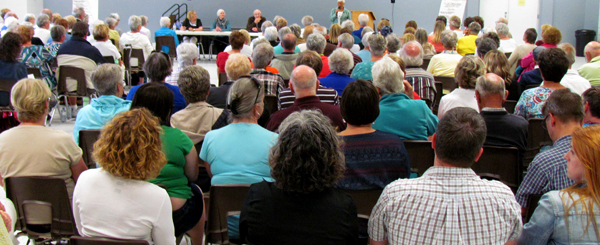Community wants its hospice back – UPDATE: board members, interim director resign
Sue Capon | Jun 30, 2015 | Comments 11
UPDATE: June 30 – Hospice president Linda Middleton and secretary Debbie MacDonald Moynes resigned from the Hospice Prince Edward board of directors today. Interim director Angela Jodoin resigned from her position this afternoon. Just two members remain – past president Birgit Langswich and treasurer Mary Camp.
Countylive is told there will be hospice staff at the residence every day and volunteers are also on duty. More here
June 29 – Volunteers and supporters of Hospice Prince Edward, among about 250 residents at Monday’s community meeting, made it clear they want their hospice back. And they want it the way it was before the resignation of executive director Nancy Parks last month and of four board members since January.
It was made clear volunteers would continue to support hospice, but they do not wish to step into the roles of personal support workers and nurses and they seek transparency from the now four-member board.
Hospice President Linda Middleton stated the board would not attend the community meeting as it had hosted a private gathering last week with about 20 volunteers, the Community Care Access Centre, the interim administrator and legal counsel.
Stuart Brown gave a tribute for Parks’ dedication and achievements at Hospice Prince Edward over the past six years that led to the creation of the residential home. Emcee Bev Campbell noted questions surrounding Parks’ resignation could not be addressed at the meeting.
Rev. Audrey Whitney trained volunteers as service co-ordinator at Hospice Prince Edward until she retired last July. She’s returning Tuesday – but this time it will be bedside supporting her sister Barbara in her final days.
“Tomorrow I will be a family member of hospice. My sister, who has suffered a major stroke, will be coming there to spend her last few days. And the volunteers have said ‘we’re going to be there for you.’ I know they will.
“Today when we were planning my sister’s journey over here I was asked if I would give medication. I said no. Volunteers don’t give nursing care. That is not part of their role to play. And I just want to hang onto my sister’s hand and that’s what our volunteers want to do – to provide good, caring, loving care.
Karen Chapman’s husband is a resident of Hospice and she told the meeting she was forced to have discussions with the Community Care Access Centre (CCAC) about 24-hour care as her husband’s condition was worsening.
“My step-son, from Peterborough, has been staying with him most of the time. We have found we have had to give him medications ourselves and we are not comfortable with it and sometimes his father will fight him on it,” she said. “We’ve had to change him because he can’t do it and I can’t do it alone. Now we are getting 24-hour care but it may have to do with a second resident being there and now going to get a third one with Audrey’s sister.”
Chapman thanked the volunteers for their support, “especially Pat Dye who came to my house every Sunday so I could go to church.”
She said her church, Wellington United, was very involved in support of hospice and was afraid that because of the uproar with the board, they will find their donations down until their house is in order. A few members of the audience agreed, but most pledged their belief in the programs, offered free of charge.
Earlier this year, Kevin Gale’s family and friends raised $5,000 at Hike for Hospice because last summer, the family learned that having a residential hospice made his dad’s last four days comfortable, and allowed him to pass with dignity.
Two months before his death Graham Gale told his son he did not want to go to the hospital to die and ‘I don’t want to die in the house that your mother has to come home to when I’m gone.’
“Thankfully we had hospice. Thankfully we had Nancy and her staff, and thankfully we had all of you (volunteers and supporters). For the worst four days of our lives, we were comforted by the care and comfort and support of hospice and you have no idea what that means to us.
“I dare say that from what I’ve heard, what I read and what I hear, that the warmth and compassion in my opinion has been replaced by secrecy, conflicts, hidden agendas and by bullying.
“I have a list of the 2014-15 board of directors with 12 people on it. One resigned last August, one passed away, one became (interim) executive director and five people have resigned since January 1st this year. That’s a problem, folks. There’s a problem here.
“I’m hearing of volunteer meetings with lawyers present. This is a bullying tactic in my world… And who is paying for that lawyer? If it’s from the money (the community) has raised to the tune of $800,000, that is just plain wrong.
“I will do, personally, whatever I can do to help the volunteers to make sure that other families in the community have the same opportunity our family had to have love, compassion and comfort and allow their member to die with a level of dignity. Thank you for coming tonight and thank you for everything you did for our our family.”
Mark Larratt Smith, a former board member and chair, shared concerns about changes to bylaws and how some meetings were conducted. There was also no annual report for 2014, including a financial report, and no annual general meeting, as usual in the fall, to present the business of the board.
“How can a 10 minute, 11-person meeting possibly have been legitimate when it disenfranchised all of the volunteers and donors while keeping them in ignorance… The process implemented by the board has had the effect of removing all accountability to the community… The board has become a sort of free-floating, self-perpetuating balloon with no accountability to anyone.”
He noted the coming changes MPP Todd Smith spoke of to the not-for-profit accountability act are long overdue.
“There are two radically different visions,” he said. “The first is the one, when I was chair, set to provide a comfortable, community-based alternative for terminally-ill patients who are unable to remain at home… The second vision is the priority of the LHIN acting through the CCAC for, essentially, cheap institutional care for the dying. In other words, cut-rate hospital beds without hospital care, or funding.”
Marianne Malachowski said she was one of the people attending that short meeting on a stormy January evening and was told “we were voting for a firewall so that the foundation money could not be touched by the corporation or the LHIN. That’s what we understood.”
Mark Davis stated this hospice belongs to each and every person in this community who supported it. To applause, he suggested the evening’s meeting “result in a request to either ratify the bylaws, making transparency the number one priority, or if they fail to do so, they are officially asked to step down and a new board be created.”
The husband of a former hospice employee, warned the group to educate themselves on the roles of the CCAC and the LHIN. “The board can change, and can have all the great ideas they want but the LHIN controls the money and the CCAC dictates the level of care. ”
Though emcee Bev Campbell noted the gathering “does not have the force of anything since it’s not a constituted body”, it was a big crowd and a motion should still speak loudly.
“What a wonderful, passionate group of people here tonight,” said Eleanor Lindsay MacDonald, “We should be proud of ourselves because we’ll never stop fighting for things we have to fight for to keep our healthcare.”
MacDonald read a draft motion to resolve the people at the meeting strongly urge the board of Hospice Prince Edward to restore the membership revisions from its previous bylaws Sept. 20, 2010 to make all active community volunteers and donors eligible for membership including the right to vote at annual and special general meetings on the Hospice foundation and corporation.
The audience members raised hands in agreement.
A sign-up sheet was filled out by those wanting to stay informed, and possibly join a new group to help re-establish lines of support and communication.
Filed Under: Featured Articles
About the Author:




































Thank you Teresa for the clarification re. finances and roles of each person involved.
ADJ -other hospices have their own staff -which is not provided by CCAC. (see Renfrew Hospice Website)
I think Theresa covered it well. Not sure there is a problem. If it is all about getting someone’s job back then get in line as I am certain the devastation at Shire Hall would take precedence! We have lost many good employee’s and fairness for all should come forward. I didn’t see the community coming forward for the others that have been tossed aside at Shire Hall!
It would seem everytime The County enters into a deal with the LHIN it goes bad later….how many times is this that proper health care has been threatened.Is there evidence of bullying and top heavy cost management? Why does the County continue to deal with them? Is there no alternative? What are pallative care Hospices doing elsewhere?
I see a couple of commenters have questions about the financial operation of a hospice. This is a cut and past from Hospice Prince Edward’s website. You could check out the site, itself, if you have other questions. There is a FAQ section.
The decision to fund the residential hospice through the CCAC is determined by the South East Local Health Integration Network (SELHIN). The CCAC has been provided with funds ($190,000) for enhanced palliative care and personal support services to be provided in the residential hospice. This represents an enhanced extension of home care services to individuals in their last weeks of life.
“Hospice Prince Edward’s staff will consist of professional clinical providers, as well as a residential manager and trained hospice volunteers. The clinical staff will be provided by the CCAC contracted provider (TBD). The resident will be supported on the basis of the needs required for their comfort and care, eg. RN, RPN, PSW. The level of care will be determined by the CCAC Care Coordinator in conjunction with the case manager at the contracted agency and the HPE Clinical Coordinator.
Hospice includes the services of an interdisciplinary team of health care professionals from the community:
Physicians (the residents own physician and the hospice physicians, who are specialists in controlling pain and other symptoms of serious illness) prescribe medications and other methods of pain and symptom control.
Nurses are experts at maintaining resident comfort. They assess the resident frequently and help family members provide the necessary support.
Personal Support Workers (PSW) provide personal care and help the resident and family with activities of daily living. They also provide companionship and valuable emotional support.
Social Workers coordinate community resources and help the resident and family with non-medical concerns. They can help family members with their relationships, help them plan for the future and ease other emotional difficulties.
Chaplains and spiritual counselors help residents and families cope with spiritual questions and concerns at the end of life, either directly, or by coordinating services with the resident’s and family’s spiritual advisors.
Bereavement coordinators help residents and families deal with grief. Grief support services continue for at least one year after the death of a hospice resident.
Volunteers provide companionship and emotional support and offer help in a myriad other ways.”
No one wants to see the Hospice shut their doors. The volunteers are not being asked to take on the role of nurse or PSW but to increase the support given when needed. The volunteers provide a valuable service to these residents and families and we are thankful for them. To answer questions about service it needs to be clear that the funding has always been an enhanced home funding model. Families are expected to play a role in the care of their loved ones when possible. That is how it has always been. somewhere along the line the communication has become confused. CCAC provides the funding for all of the care provided and for the supplies. If HPE wants to have control of the service is they will have to fund it themselves. Since that is highly unlikely, all parties must come together and discuss the future of hospice.
Congratulations to all of the dedicated volunteers who came forward to hold this information session for the public.
There still appears to be a lot of unanswered questions.
Can someone explain where the funding comes from to run the hospice? Does the MOHLTC and the Foundation both support the financial end of things? Also, does CCAC provide staff at no cost to the hospice? Who manages the day to day finances and are these audited on a regular basis?
Thanking you in advance for clarification –
A lot from the hearts but very little information was provided on operational issues. This residence needs to operate effectively and within budget and policy. Something seems to be lacking in this whole story.
It was one of the most meaningful, well-planned and cohesive meetings I have ever attended. Until that meeting, I was not fully cognizant of the issues. I certainly had no idea The Board had made themselves beholding only to themselves. This is not the way this community works. I, personally, wish to thank Bev Campbell for her professionalism and Mark Larratt-Smith for his straightforward contributions. Also, thank you to all of the organizers and to all of the “members” who spoke and questioned from their hearts. I am overwhelmed by this community.
I think a start would be to beg Nancy to come back!! That would be a start to the “community getting their hospice back”!! It is quite clear to me that she was doing an excellent job and is really needed at our community Hospice House!! Let’s get that by-law reversed, get a new Board with accountability and move forward with transparency!!
Could you please clarify what exactly is the core problem. I have read many of the articles in the paper but am still not sure what is the main issue. What do you mean exactly, “the community wants its hospice back?” Is it a funding issue, lack of professional caregivers oar something else? Thanks in advance to whomever can speak clearly on this issue.
Thank you Sue for your very thorough and timely report on the Hospice Community meeting last evening. You captured the thoughts and feelings of many of the 250 County residents who attended. The message is very clear, the community wants it’s Hospice back.